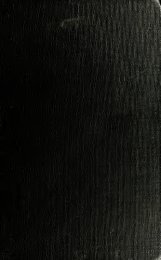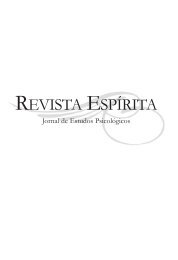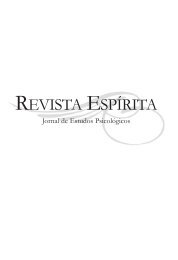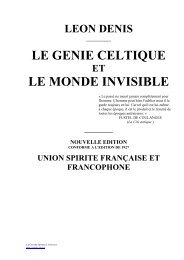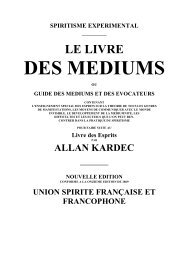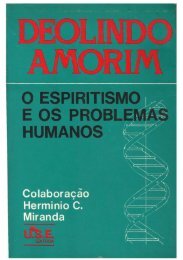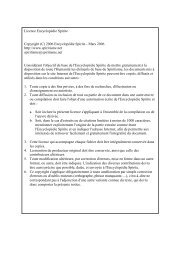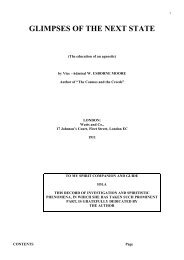'Twixt two worlds : a narrative of the life and work of William Eglinton
'Twixt two worlds : a narrative of the life and work of William Eglinton
'Twixt two worlds : a narrative of the life and work of William Eglinton
Create successful ePaper yourself
Turn your PDF publications into a flip-book with our unique Google optimized e-Paper software.
ut<br />
Brought to Book." 151<br />
The success <strong>of</strong> <strong>the</strong> last case, in which <strong>the</strong> writing was actually seen in course <strong>of</strong> execution,<br />
induced Mr. <strong>Eglinton</strong>, who has always taken a lively interest in <strong>the</strong> development <strong>of</strong> his own<br />
powers, to make practical experiments with a view to regularly obtaining similar results, <strong>and</strong><br />
he has always willingly co-operated with any earnest inquirer in fur<strong>the</strong>ring efforts to this end.<br />
A case in point came to my notice while <strong>the</strong>se sheets were passing through <strong>the</strong> press. Dr.<br />
Herschell (M.D.,- Lond.), <strong>and</strong> an amateur conjurer <strong>of</strong> great ability, whose interest in Spiritualism<br />
is <strong>of</strong> many years' st<strong>and</strong>ing, after some satisfactory seances held during <strong>the</strong> latter half <strong>of</strong> 1885,<br />
specially designed a slate for <strong>the</strong> purpose <strong>of</strong> developing direct writing under conditions which<br />
might possibly allow, in due course, <strong>of</strong> <strong>the</strong> writing being seen while being executed. Fig. 30<br />
is a drawing <strong>of</strong> <strong>the</strong> slate, which measures nf inches by 9| inches. Over one surface a thin<br />
board is screwed, to one end <strong>of</strong> which a frame is attached. In this frame, <strong>and</strong> covering a<br />
portion <strong>of</strong> <strong>the</strong> surface <strong>of</strong> <strong>the</strong> slate not screened by <strong>the</strong> thin board, slides a piece <strong>of</strong> rubycoloured<br />
glass. The space under <strong>the</strong> glass, as far as <strong>the</strong> observer is concerned, is absolutely<br />
dark, <strong>and</strong> yet a piece <strong>of</strong> pencil, if dipped in luminous paint, is perfectly visible, <strong>and</strong> any<br />
movements easily perceived.<br />
An experiment was made with this, Dr. G. Wyld being <strong>the</strong> first to obtain successful<br />
:— results. He sends me <strong>the</strong> following account <strong>of</strong> what took place " I took with me to Mr.<br />
<strong>Eglinton</strong>'s a friend, Mrs. M , who was anxious to obtain advice as to <strong>the</strong> condition <strong>and</strong><br />
treatment <strong>of</strong> a dear friend. She used her own slates, viz., thin metal book slates without<br />
frames, so that when closed <strong>the</strong> leaves were in contact, <strong>and</strong> I used <strong>two</strong> <strong>of</strong> my own slates tied<br />
so tightly toge<strong>the</strong>r that I could not insert <strong>the</strong> thin blade <strong>of</strong> a penknife. Mrs. M having<br />
placed a crumb <strong>of</strong> yellow chalk pencil between <strong>the</strong> leaves <strong>of</strong> her slate, <strong>the</strong>y were pressed in<br />
close contact to <strong>the</strong> under surface <strong>of</strong> <strong>the</strong> flap <strong>of</strong> <strong>the</strong> table, <strong>the</strong> near edge being visible to us.<br />
We <strong>the</strong>n, having all joined h<strong>and</strong>s, heard <strong>the</strong> sounds <strong>of</strong> writing, <strong>and</strong> when we opened <strong>the</strong> leaves<br />
<strong>of</strong> <strong>the</strong> slates found yellow chalk writing, not only at <strong>the</strong> end <strong>of</strong> <strong>the</strong> slate next Mr. <strong>Eglinton</strong>'s<br />
h<strong>and</strong>, but at <strong>the</strong> distant end <strong>and</strong> across <strong>the</strong> slate, <strong>and</strong> <strong>the</strong> writing contained apposite replies to<br />
questions put by Mrs. M unknown to him. My <strong>two</strong><br />
,<br />
closely tied slates were <strong>the</strong>n<br />
used. These we held above <strong>the</strong> table, in <strong>the</strong> air, <strong>and</strong> we heard <strong>the</strong> sounds <strong>of</strong> writing. On<br />
examination, after cutting <strong>the</strong> string, we found both <strong>of</strong> <strong>the</strong> slates covered with writing from top<br />
to bottom, <strong>and</strong> containing apposite replies to <strong>two</strong> questions put, one by myself, <strong>and</strong> <strong>the</strong> o<strong>the</strong>r by<br />
Mrs. M . Our third experiment was one which, I believe, has seldom been successfully tried<br />
before, <strong>and</strong> never with <strong>the</strong> slate used. We removed <strong>the</strong> glass <strong>of</strong> Dr. Herschell's slate, <strong>and</strong> saw<br />
that <strong>the</strong>re was no writing on <strong>the</strong> slate floor, <strong>and</strong>, having placed <strong>the</strong>reon a crumb <strong>of</strong> slate pencil,<br />
<strong>and</strong> a question written on paper, placed face downwards, under <strong>the</strong> covered portion <strong>of</strong> <strong>the</strong><br />
slate, we reinserted <strong>the</strong> glass lid, <strong>and</strong> while we firmly pressed <strong>the</strong> frame<strong>work</strong> <strong>of</strong> this apparatus<br />
to <strong>the</strong> table, we looked through <strong>the</strong> glass lid. We heard writing going on, but we could not<br />
see <strong>the</strong> movements <strong>of</strong> <strong>the</strong> pencil, as <strong>the</strong> glass was not sufficiently transparent ; but on<br />
removing it we found a message pertinently replying to <strong>the</strong> question put by Mrs. M .<br />
This was an interesting experiment, <strong>and</strong> seems to indicate that <strong>the</strong> day may not be far distant<br />
when through a more transparent glass lid than that used, <strong>the</strong> writing may be watched as<br />
it proceeds, <strong>and</strong> thus afford a crowning evidence <strong>of</strong> psychography."<br />
Mr. Mair-Rolph, <strong>of</strong> Beaufield, Jersey, bears emphatic testimony to <strong>the</strong> identity <strong>of</strong> <strong>the</strong><br />
communicating intelligences in a long letter which he published in <strong>the</strong> columns <strong>of</strong> Light. He



